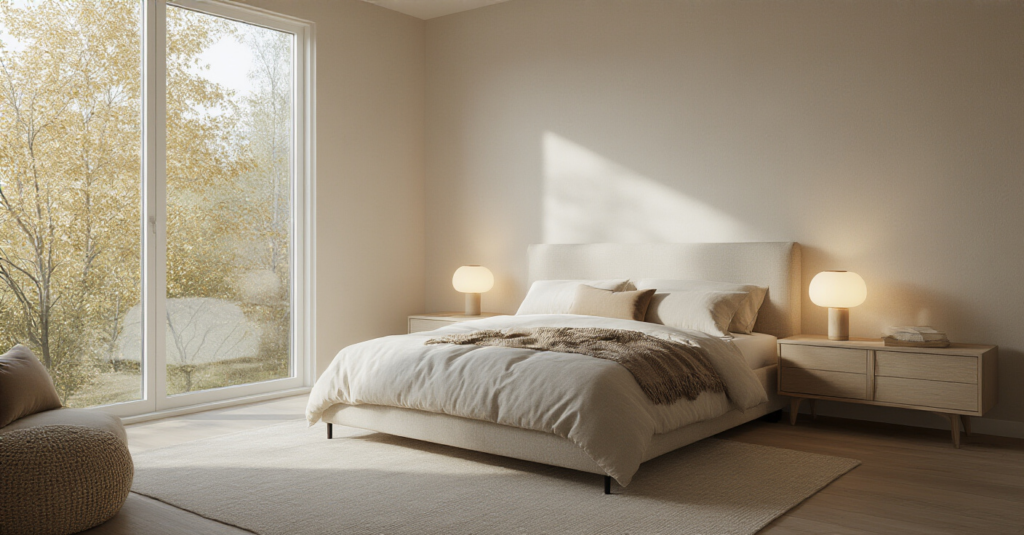I’ve noticed something funny over the years. I spend my days helping people design these beautiful, functional outdoor rooms—patios that feel like living rooms, gardens that become private retreats. People are finally seeing the value in extending their home beyond its four walls. But then, I’ll see their bedroom, and it’s the most neglected space in the house. It’s become a dumping ground for unfolded laundry, a charging station for a dozen devices, and a home office for late-night emails.
We’ve forgotten what a bedroom is for. It’s not just a box to sleep in; it should be the ultimate sanctuary. It’s the indoor equivalent of finding a quiet, sheltered spot in a forest, a place where you can genuinely disconnect and recharge your batteries. Most of the advice out there gets caught up in fleeting trends and fancy decor. What truly matters is creating an environment that works with your body’s natural rhythms to help you relax. Let’s talk about how to actually do that.
Foundations for a Serene Sanctuary (Part 1)
Before you buy a single throw pillow, we need to get the bones of the room right. Just like you can’t plant a beautiful garden on a foundation of concrete and weeds, you can’t create a relaxing bedroom if the layout is chaotic and the space is full of visual noise. These first steps are the most important because they set the stage for everything else.
Think of this as clearing the land. It’s not the most glamorous part, but it’s the work that determines whether your sanctuary will truly flourish or just end up as a prettied-up storage closet.
1. Assess Room Layout for Optimal Flow and Comfort
Let’s get one thing straight: how you arrange your furniture has a massive impact on how you feel in a room. We have a primal need for security, especially when we sleep. If your bed is in a weird spot—like directly in line with the door or with your back to the entrance—your brain stays on low-level alert all night. You can’t fully relax if you subconsciously feel vulnerable. The goal is to create a layout that feels secure, calm, and easy to move through.
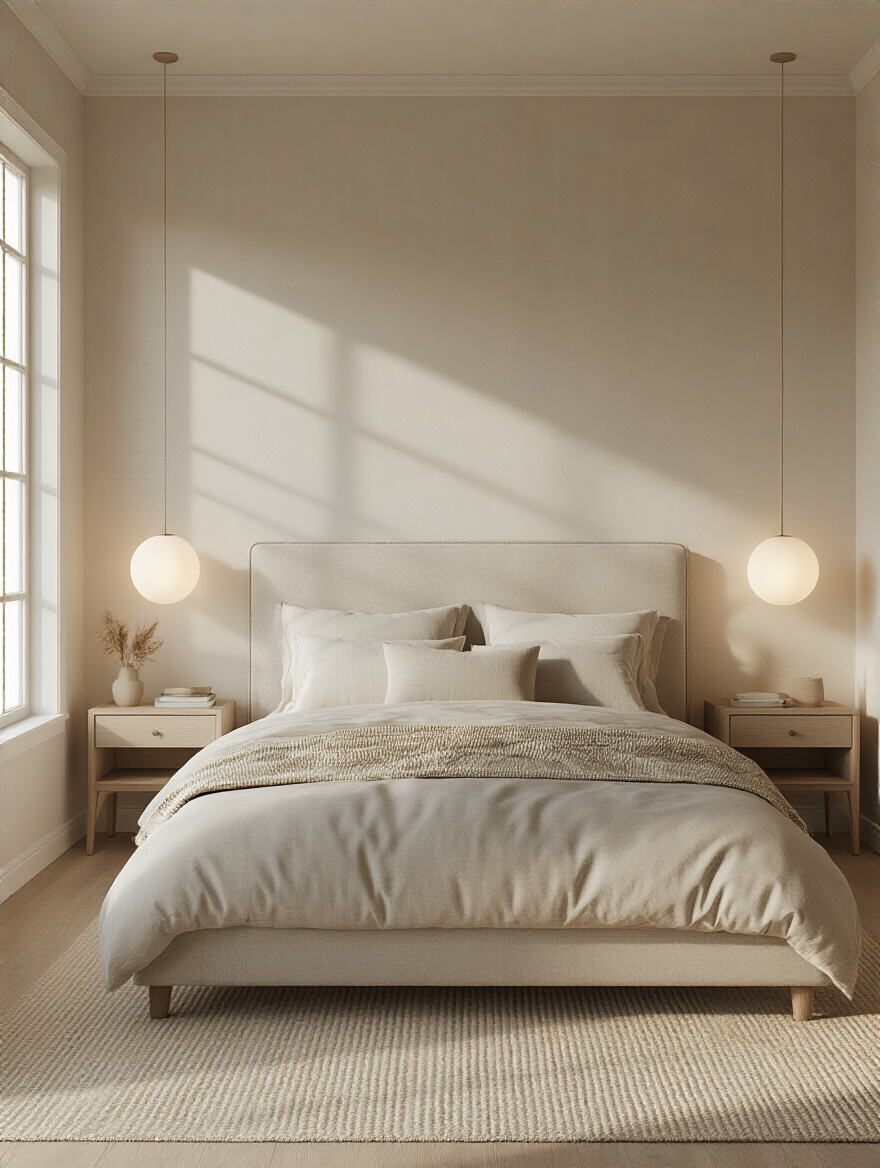
The biggest mistake people make is pushing all the furniture against the walls and calling it a day. The “commanding position” isn’t just Feng Shui jargon; it’s about giving yourself a clear view of the door without being directly in its path. Place your bed against a solid wall, preferably the one furthest from the entrance. Make sure you have clear, easy pathways around the bed and to the door. This isn’t about interior design rules; it’s about engineering a sense of calm from the ground up.
Once you have the big pieces sorted, the next step is to clear the path for tranquility, which means tackling the clutter head-on.
2. Declutter Ruthlessly to Reduce Visual Stress and Improve Energy
Every object in your room demands a tiny bit of your attention. A pile of clothes, a stack of mail, unused gadgets—they all create visual static that keeps your mind buzzing when it should be winding down. A cluttered bedroom is a stressed bedroom, period. Decluttering isn’t about minimalism for its own sake; it’s about removing the things that actively prevent you from relaxing. Think of it like weeding a garden. You have to pull out all the unwanted stuff to give the valuable plants room to breathe.
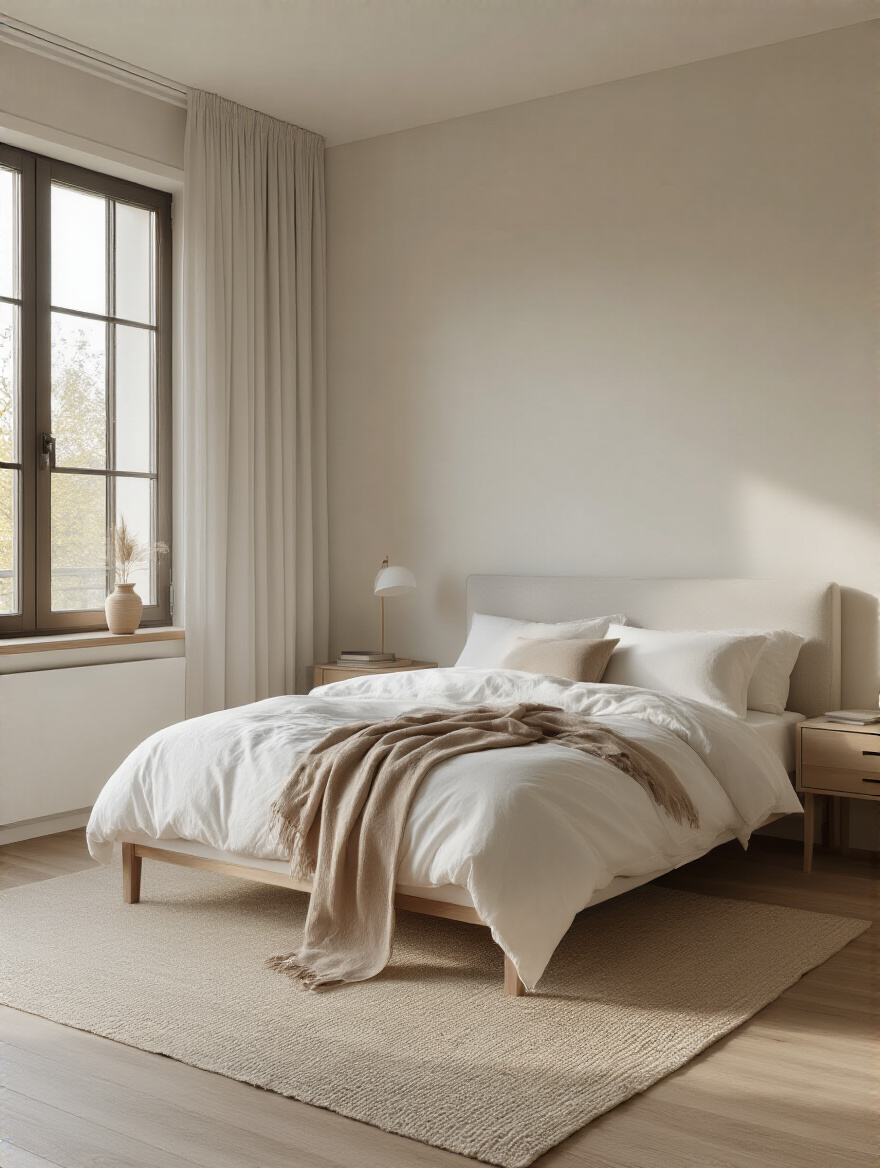
So, get ruthless. If it doesn’t help you sleep, relax, or get dressed, it does not belong in your bedroom. This is the shortcut I wish I’d known earlier: stop shuffling things around. Grab three boxes and label them “Keep,” “Donate/Trash,” and “Relocate.” Don’t stop to reminisce. If something belongs in another room, put it in the “Relocate” box and deal with it later. The only goal here is to create visual silence so your mind has a chance to follow suit.
With a clean slate, you can now use color to paint a backdrop of calm.
3. Select a Soothing Color Palette for Walls and Linens
Color isn’t just decoration; it’s a mood. Bright, high-energy colors like reds and oranges are fantastic for a kitchen or a creative space, but they’re disastrous for a room built for rest. They are visually stimulating and can literally elevate your heart rate. For the bedroom, you want to borrow your palette directly from nature’s most calming scenes: the soft blue-gray of a pre-dawn sky, the muted green of moss on a tree, the warm beige of sand, or the deep charcoal of a storm cloud.
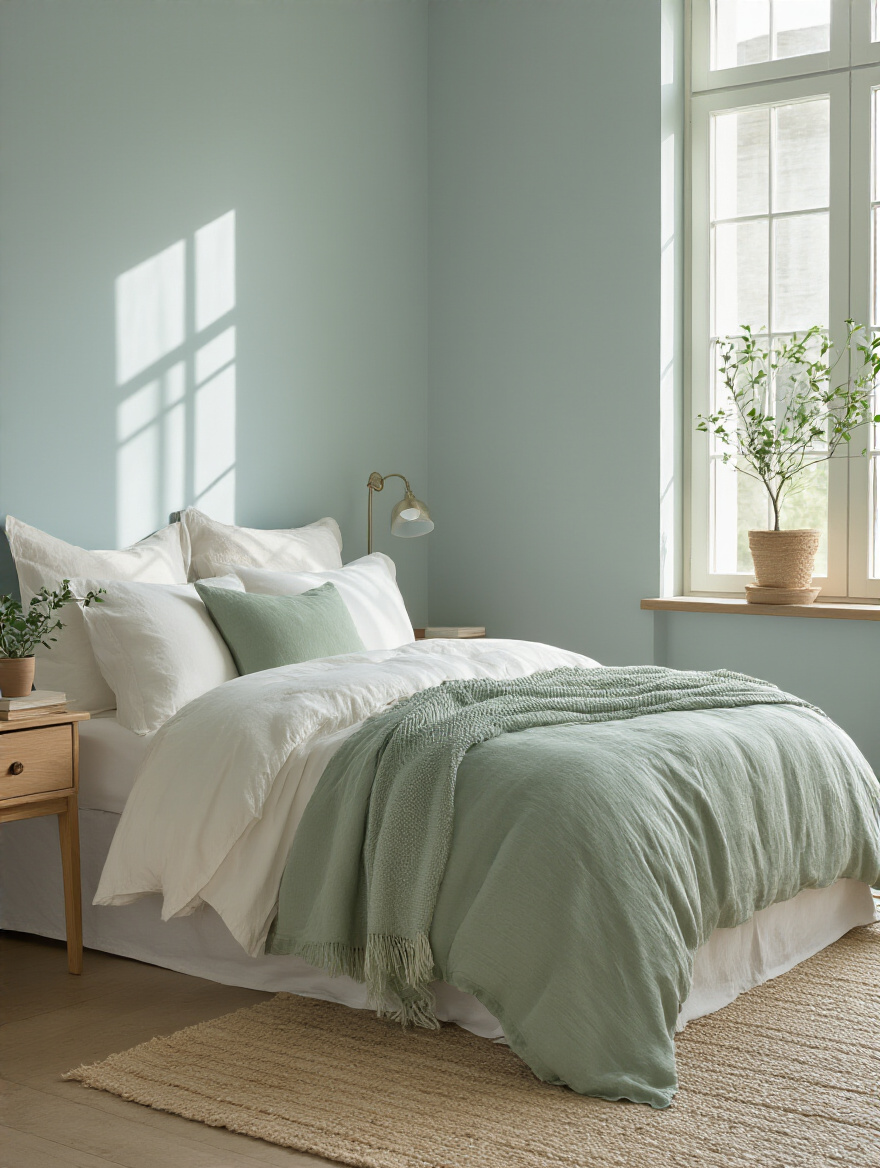
Forget fleeting color trends. Stick with colors that have a proven calming effect. A great shortcut is to choose one main, muted color you love and build the entire room around different shades and tones of it. A sage green wall with darker green pillows and a light, oat-colored linen duvet, for example, creates a layered, natural look without being busy. The BS everyone tells you is that beige is boring. It’s not. It’s grounding. The trick is to layer textures within that simple palette.
Your color palette sets the mood, but light is what brings it to life and tells your body when it’s time for sleep.
4. Prioritize Effective Light Control for Deeper Sleep and Ambient Mood
This is non-negotiable. Our bodies are hard-wired to respond to light. Bright, cool light says, “Wake up! Time to hunt and gather!” while dim, warm light and then darkness says, “Time to shut down and restore.” Yet, most of us live with streetlights creeping through the blinds and the glow of tiny electronics piercing the dark. Even a little bit of light can disrupt the production of melatonin, the hormone that governs sleep.
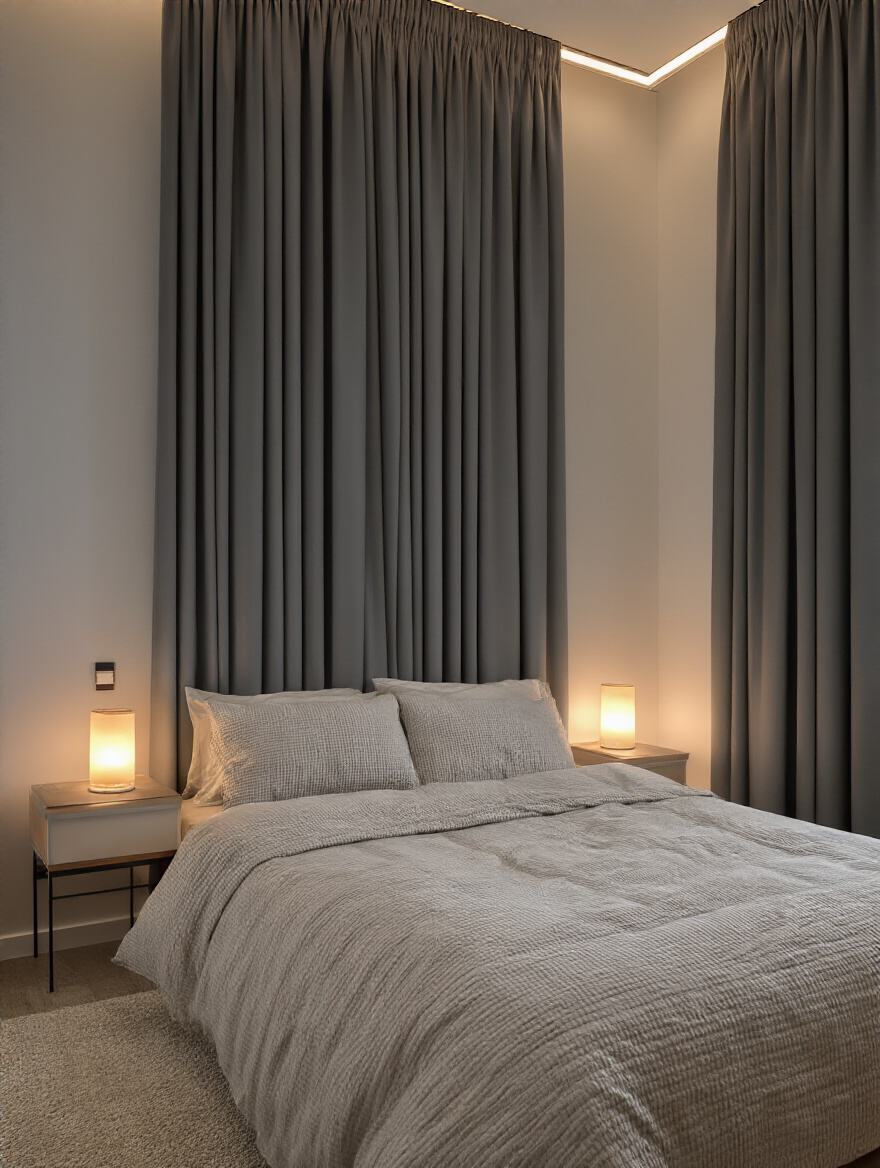
The solution is to create a cave. You need total, absolute darkness for sleeping. Invest in high-quality blackout curtains or blinds that completely block outside light. And I mean completely—no little slivers on the sides. Use small pieces of electrical tape to cover the tiny LED lights on your TV, chargers, and air purifier. For the evening, ditch the harsh overhead light and use dimmable lamps with warm-toned bulbs (look for 2700K on the box). It’s about mimicking the sunset to tell your body it’s time to rest.
Foundations for a Serene Sanctuary (Part 2)
Once you’ve set the stage with a calm layout and the right light, it’s time to focus on the things your body directly interacts with. This is where the real comfort comes in. It’s the physical foundation of your rest, and getting it right can change everything about how you feel when you wake up in the morning.
5. Choose a Comfortable, Supportive Mattress and Pillows
I used to think any mattress would do. Then I spent a week sleeping on a cheap one at a rental and my back was screaming. It taught me a hard lesson: your mattress isn’t furniture; it’s equipment for recovery. It is the single most important investment you will make for your bedroom. A mattress that’s too soft lets your spine sag out of alignment, and one that’s too hard creates pressure points on your hips and shoulders. Neither leads to good sleep.
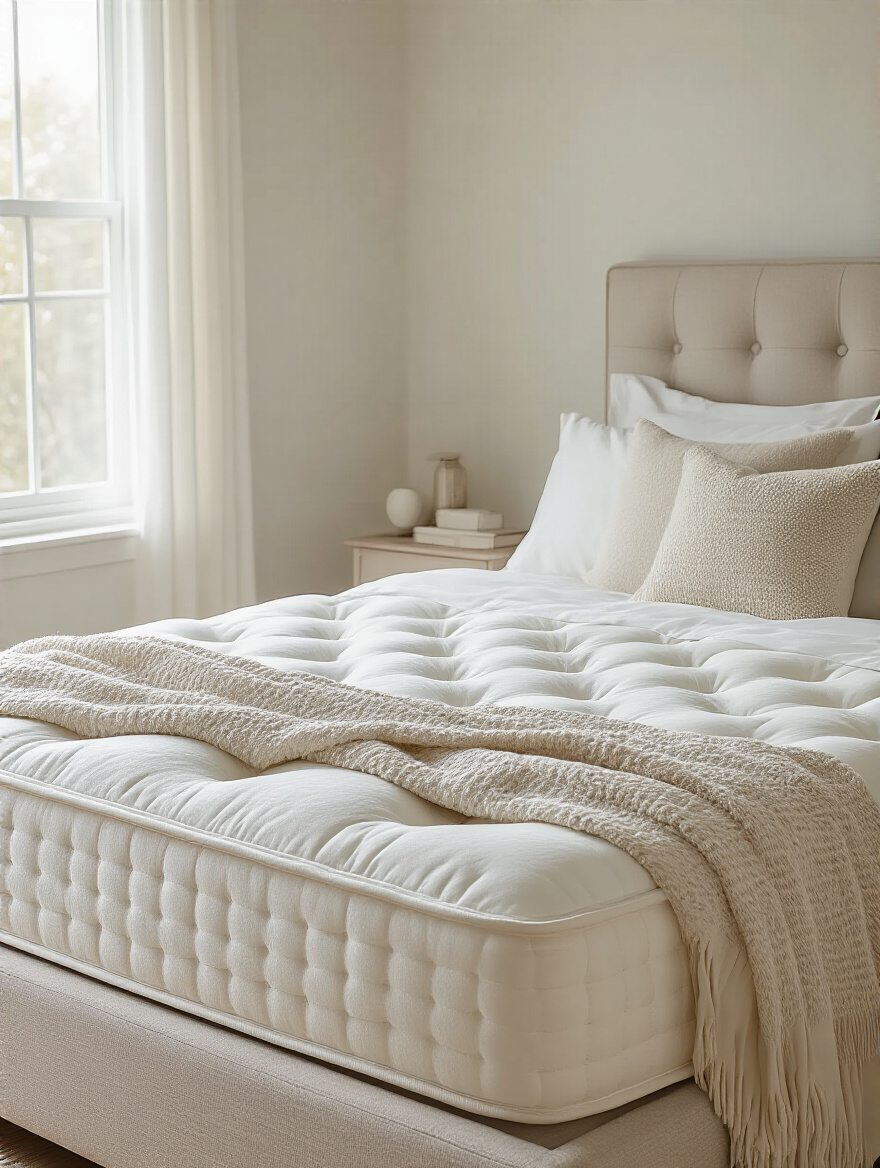
The goal isn’t “soft” or “hard”—it’s “supportive.” Your spine should be relatively straight when you’re lying on your side. For pillows, the goal is to fill the space between your head and the mattress, keeping your neck in a neutral position. A side sleeper needs a thicker pillow than a back sleeper. Don’t just buy whatever is on sale. Go to a store, lie on them for at least 10 minutes in your actual sleep position, and take advantage of the 100-night trials most online companies offer now. It’s the foundation of your sanctuary; make sure it’s a solid one.
Core Elements for Enhanced Comfort (Part 1)
With the foundational elements in place, we can start adding layers of sensory comfort. This is where we go from a functional room to a truly cozy and inviting one. It’s about engaging your sense of touch, sight, and even smell to create an environment that feels like a warm embrace.
6. Layer Bedding with Natural, Soft Textures for Inviting Warmth
A bed with just a single duvet on it looks sad and uninviting. The secret to a bed that screams “cozy” is layering. Think about it like dressing for a cool day in the garden—you don’t wear one giant parka; you wear a shirt, a sweater, and a light jacket. Layering your bed with different textures not only looks incredibly luxurious but it also gives you options for temperature control through the night. A light cotton quilt, a chunky knit throw, and some linen pillows create a rich tactile experience.
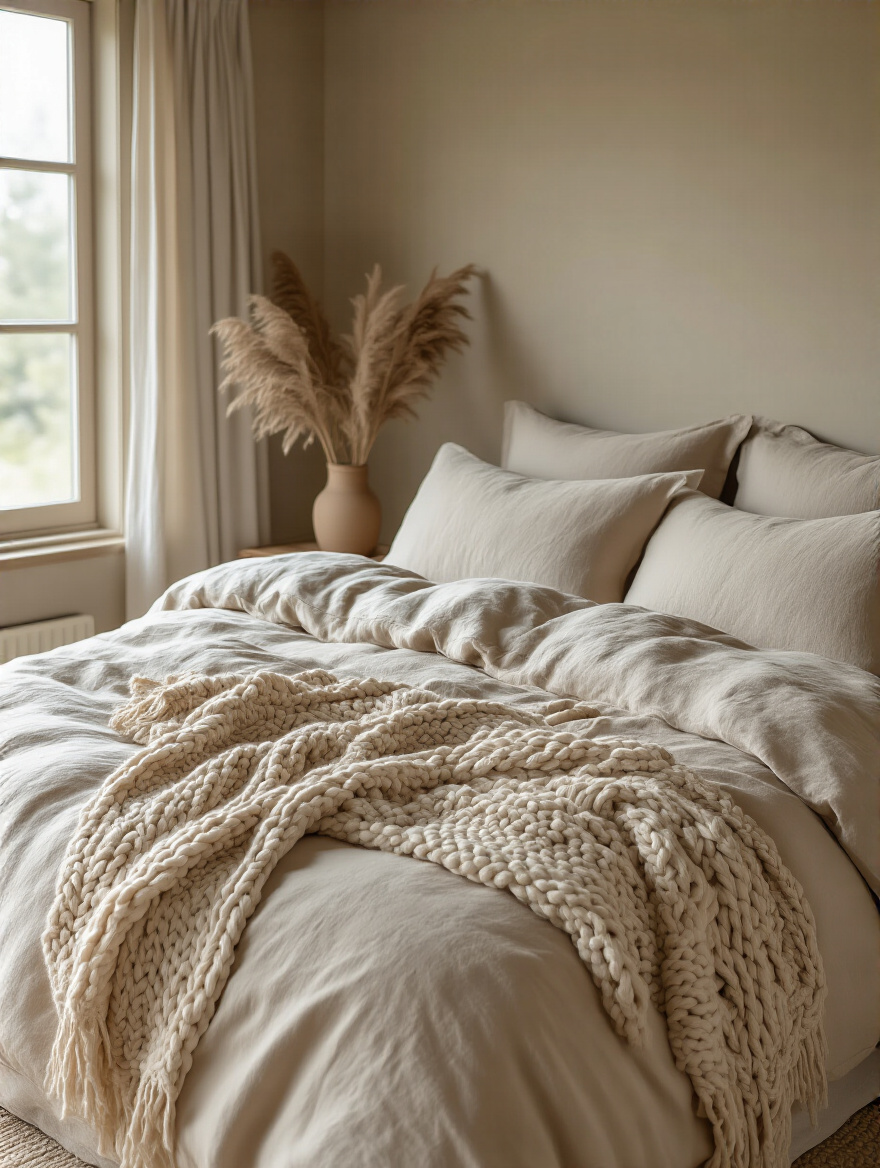
Stick to natural fibers like cotton, linen, and wool. Synthetics like polyester trap heat and don’t breathe, which is a recipe for a sweaty, restless night. Natural materials work with your body to wick away moisture and regulate temperature. A linen sheet feels cool in the summer, and a wool throw is breathable yet incredibly warm in the winter. Mix up the textures—a smooth sateen sheet against a nubby waffle-weave blanket feels amazing. It’s an easy shortcut to making your bed feel like it belongs in a five-star hotel.
From touch, we move to sight and creating that soft, welcoming glow.
7. Integrate Warm, Dimmable Lighting Solutions for Evening Ambiance
I mentioned lighting before, but let’s dive deeper. That single, harsh overhead light in the middle of most bedrooms? It’s what I call a “room-killer.” It casts unflattering shadows and puts your brain on high alert. To create a relaxing ambiance, you need to use multiple, smaller sources of light, all of them warm and dimmable. Think a pair of bedside lamps for reading and a floor lamp in the corner for a general, soft glow.
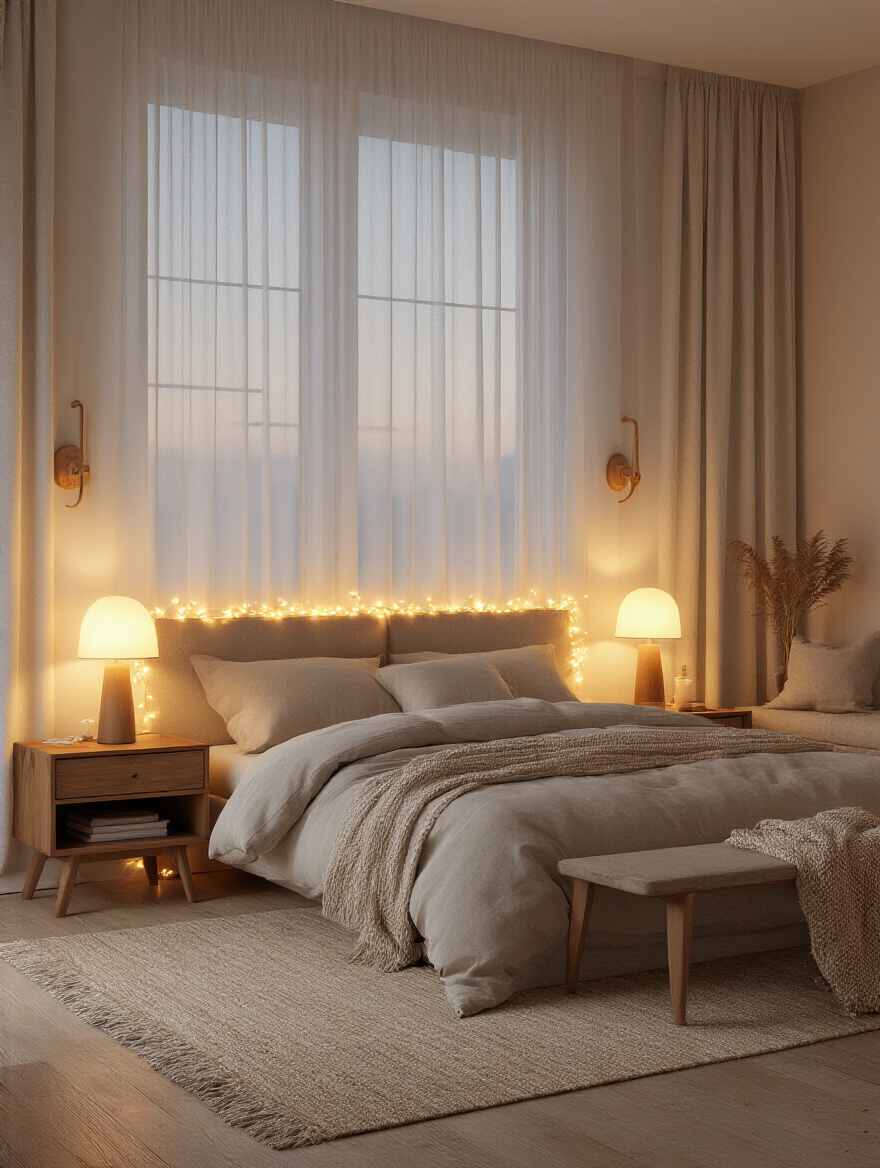
“Lighting is perhaps the most important element in creating mood. For a cozy bedroom, it must be warm, layered, and dimmable.”
The key is to switch to bulbs with a warm color temperature (again, around 2700 Kelvin). And put everything on a dimmer switch. Dimming the lights in the hour before bed is one of the most powerful signals you can send to your brain that the day is over. It’s a non-negotiable part of a healthy pre-sleep ritual and transforms the room from a functional space into a serene retreat.
Let’s carry that warmth and softness from the lights down to the floor.
8. Add Plush Area Rugs to Soften Footsteps and Insulate Sound
Stepping out of a warm, cozy bed onto a cold, hard floor is a jarring way to start the day. A plush area rug is one of the easiest ways to add instant comfort and warmth to a bedroom. It also does wonders for acoustics, absorbing sound and making the room feel quieter and more contained. It’s the difference between a room that echoes and one that feels like a quiet, intimate sanctuary.
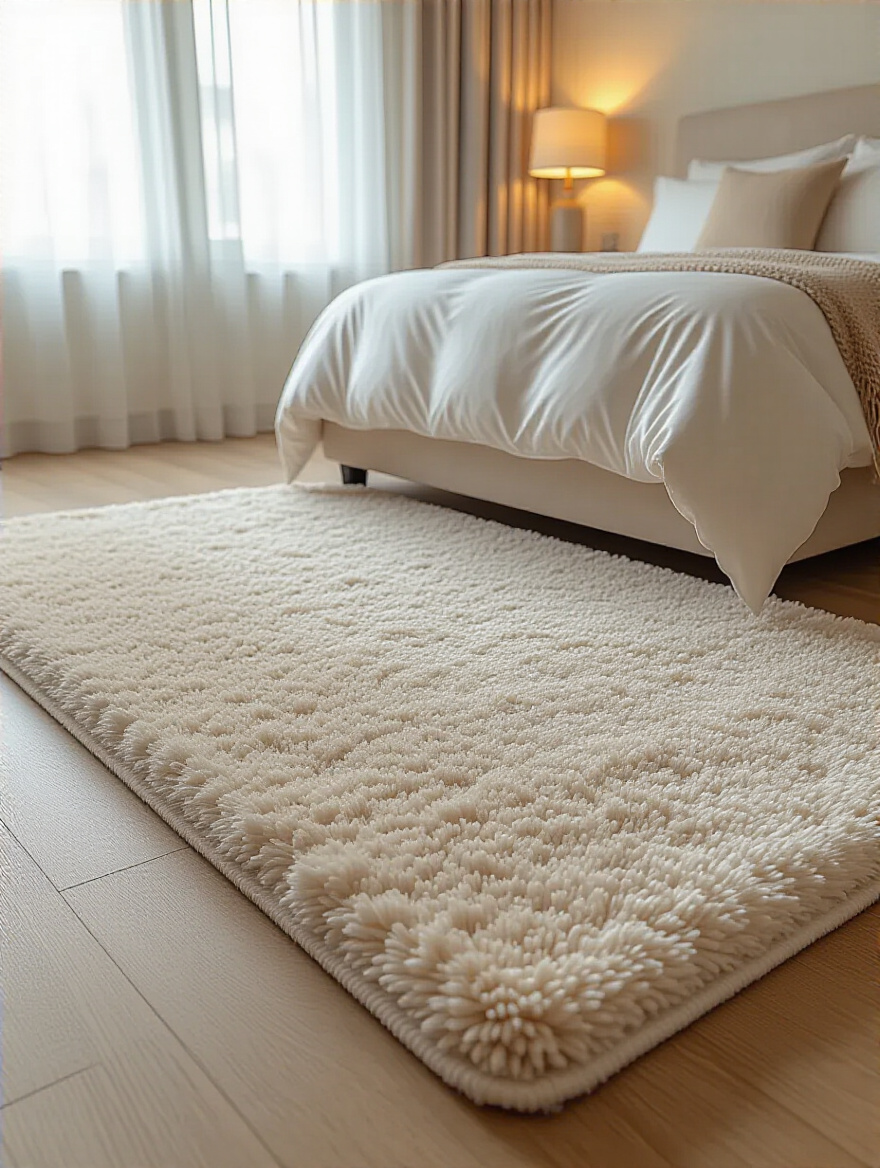
The biggest mistake I see is getting a rug that’s too small. It ends up looking like a postage stamp floating in the middle of the room. A good rule of thumb is that the rug should be large enough to extend at least 18-24 inches around the sides and foot of your bed. That way, your feet always land on something soft when you get up. Don’t skimp on the rug pad, either—it adds extra cushion and keeps the rug from slipping. It’s a small detail that makes a world of difference.
Now, let’s engage one of our most powerful senses: smell.
9. Introduce Subtle Aromas with Essential Oil Diffusers or Candles
Scent is directly wired to the parts of your brain that control memory and emotion. A calming scent can instantly trigger a relaxation response. The key word here is subtle. Your bedroom shouldn’t smell like a perfume shop. The goal is a gentle, background aroma that you barely notice, but that contributes to the overall feeling of peace. An essential oil diffuser with lavender or chamomile is a perfect way to do this.
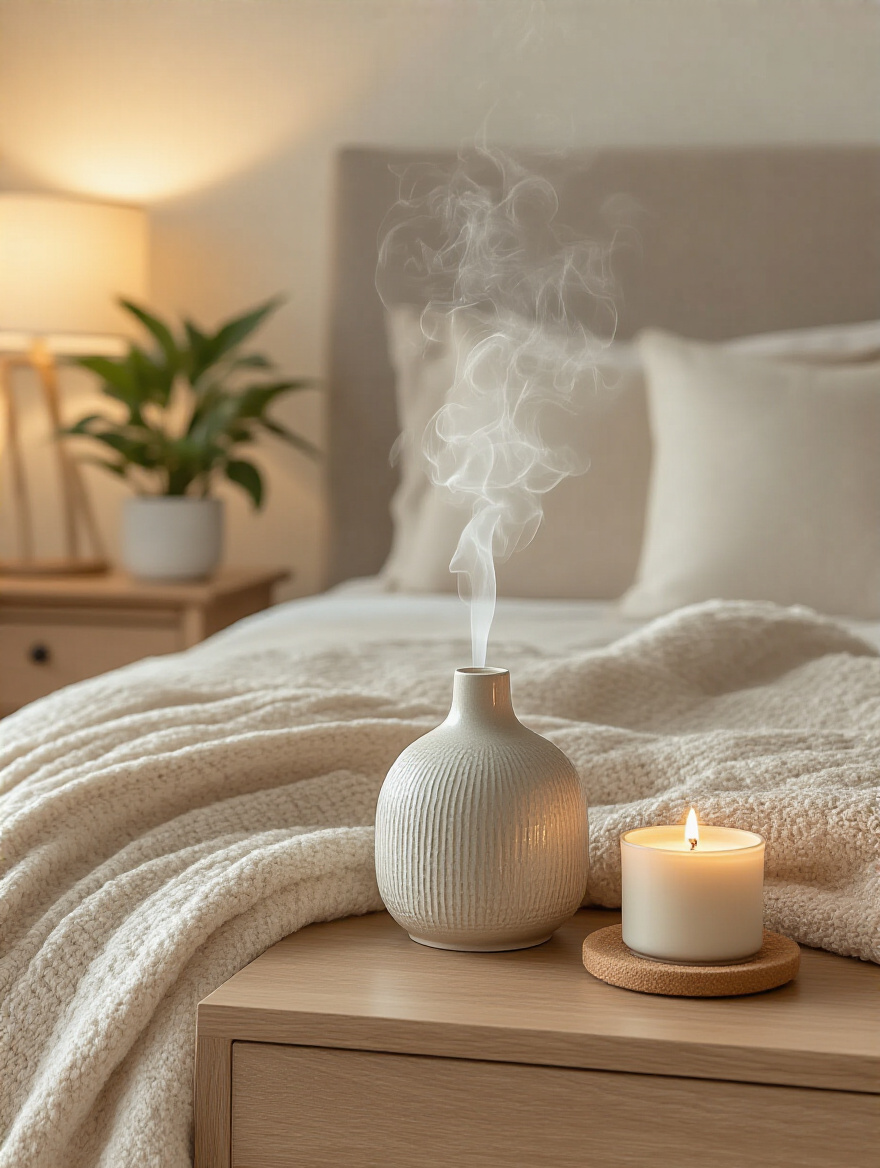
A pro tip is to use the scent as part of your winding-down ritual. Start the diffuser about 30 minutes before you get into bed. Your brain will start to build a powerful association between that specific scent and sleep. A common mistake is leaving a diffuser running all night or using artificial air fresheners, which are full of chemicals. Stick to natural essential oils or a high-quality soy or beeswax candle burned safely before you drift off.
Core Elements for Enhanced Comfort (Part 2)
We’ve covered the visible and tactile layers, but some of the most critical elements for comfort are completely invisible. These are the environmental factors that your body responds to on a subconscious level. Nailing these is the advanced level of creating a sleep sanctuary, turning your room into a finely-tuned machine for rest.
10. Optimize Room Temperature for Restful Sleep (18-21°C)
Everyone says a warm, cozy room is best. They’re wrong. The science is crystal clear on this: we sleep better in a cool room. Your body’s core temperature needs to drop to initiate sleep, and a cool environment helps that process along. The sweet spot for most people is between 18-21°C (that’s 64-70°F). A room that’s too warm will cause you to toss and turn all night.
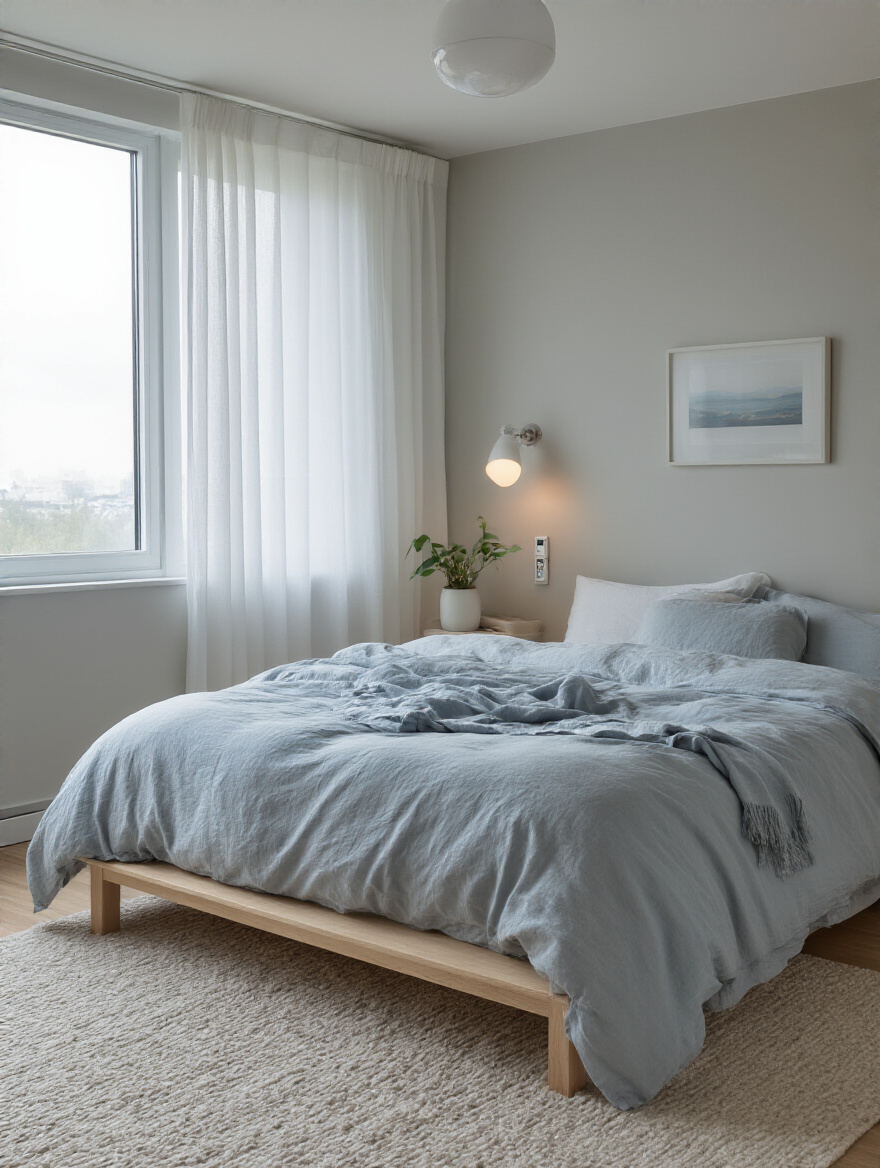
So, fight the instinct to crank up the heat. Instead, set your thermostat to the cooler end of that range and use those beautiful, layered blankets to regulate your temperature. It’s far more effective to have a cool room and a warm bed than to try and sleep in a warm, stuffy room. If you don’t have central air, a simple fan can make a huge difference in circulating air and keeping you cool. This one simple change can have a bigger impact on your sleep quality than almost anything else.
While we’re talking about invisible factors, let’s address the air itself and its counterpart: darkness.
11. Invest in Quality Blackout Curtains or Blinds for Complete Darkness
I know we touched on this, but it’s so important it deserves its own moment. When I say complete darkness, I mean it. If you can see your hand in front of your face after your eyes have adjusted, it’s not dark enough. Your skin actually has photoreceptors, meaning that light hitting any part of your body can disrupt your circadian rhythm. “Light-filtering” or “room-darkening” curtains are not the same as true blackout curtains.
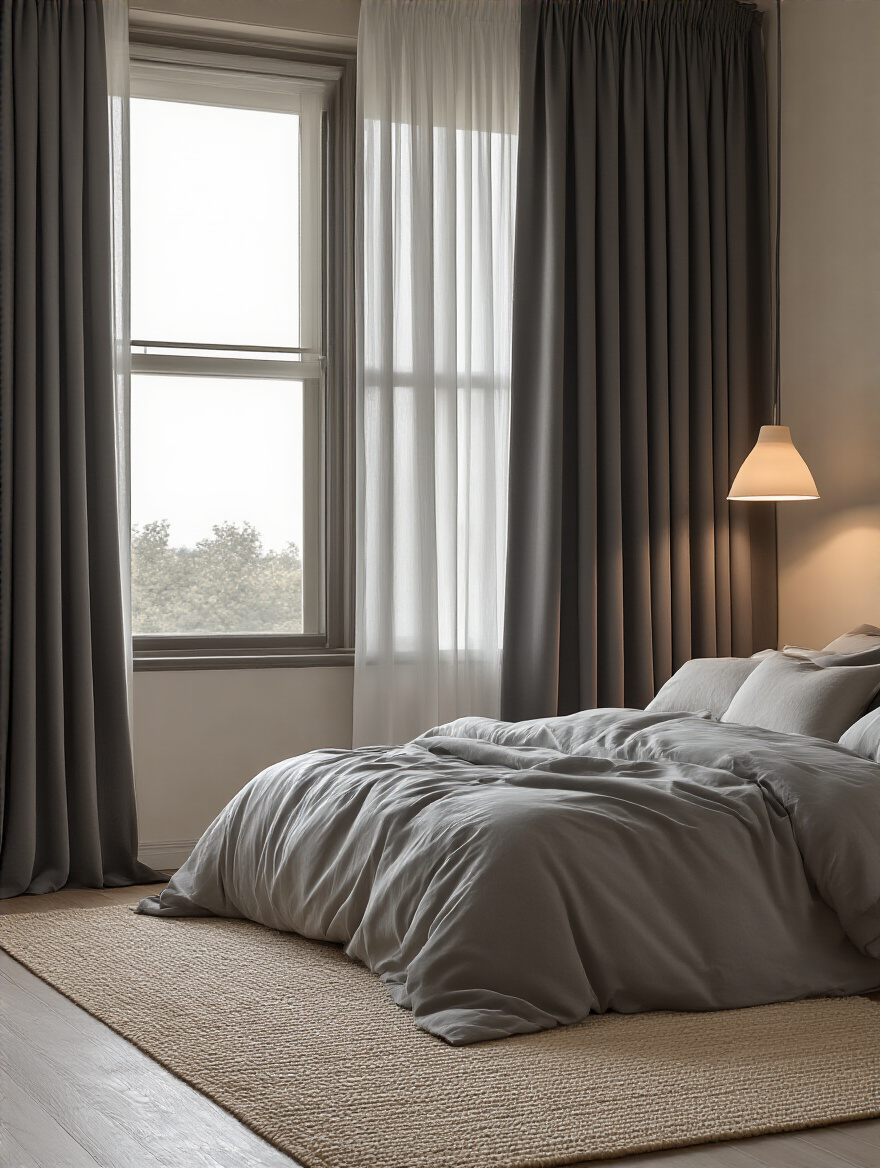
Invest in a quality set that fully covers the window frame, or consider installing blackout blinds that run on side channels to eliminate light leakage. This is particularly crucial if you live in a city or have bright streetlights outside. A good night’s sleep is one of the pillars of health, and creating a pitch-black sleep environment is one of the most effective tools you have to protect it. It’s not just a cozy idea; it’s a health imperative.
Styling and Personal Touches for Tranquility (Part 1)
With the fundamental layers of comfort established, it’s time for the final touches. These are the elements that make the space uniquely yours, turning it from a well-designed room into a personal haven. This is where you inject personality and create little moments of joy and calm that serve you throughout the day.
12. Arrange Thoughtfully Placed Accent Furniture (e.g., a Cozy Armchair)
Your bedroom shouldn’t just be a bed in a box. Creating a small, dedicated zone for non-sleep activities is one of the best ways to elevate the room into a true suite. A cozy armchair and a small lamp in a corner creates a reading nook. A bench at the foot of the bed is the perfect spot to sit and put on your shoes in the morning. These pieces send a powerful message: this room is for more than just sleep; it’s for restful activities, too.
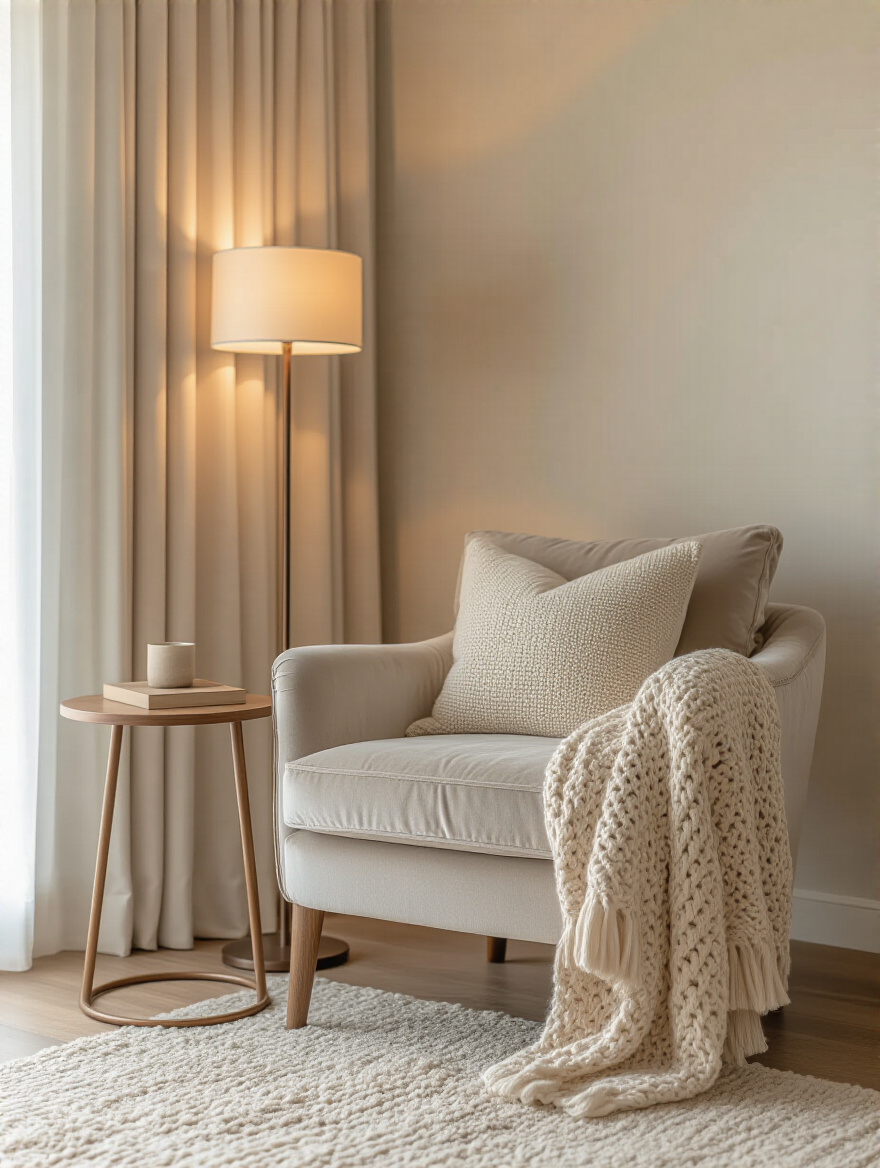
The trick is to keep your bed sacred for sleep and intimacy. By creating a separate zone for reading or quiet contemplation, you strengthen your brain’s association of your bed with sleep alone. This drastically improves sleep hygiene. You don’t need a huge room for this. Even a small, comfortable chair in a corner can define a new zone and make the entire space feel more luxurious and functional.
This same thoughtful approach applies to the textiles you use beyond your main bedding.
13. Incorporate Soft Throws and Decorative Pillows for Added Comfort
This is the easiest and most effective shortcut to making a room look and feel cozier. Throws and decorative pillows are the jewelry of a bedroom. They add color, pattern, and most importantly, texture. A chunky knit throw draped over your reading chair or a couple of velvet pillows on the bed add a layer of visual warmth that is instantly inviting.
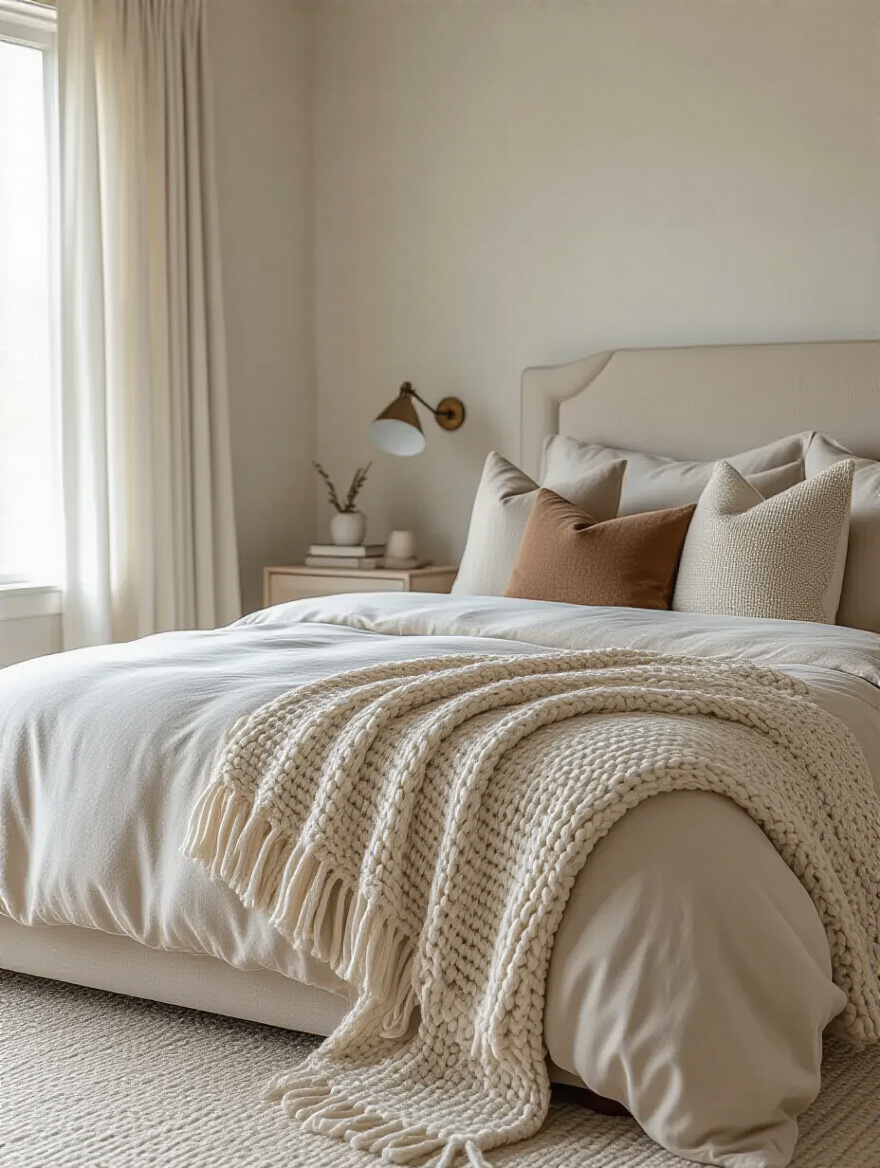
But don’t go overboard. The BS you see in magazines with 15 pillows on the bed is ridiculous and impractical. You end up with a pile on the floor every night. A better approach is the “three-layer” rule for pillows: your sleeping pillows in the back, two slightly larger square shams in the middle, and one or two smaller, textured decorative pillows in the front. For throws, one at the foot of the bed and maybe one on an armchair is plenty. It’s about a curated touch of comfort, not clutter.
Now, let’s address what goes on the walls.
14. Introduce Calming Artwork or Personal Photos (Avoid Overstimulation)
The art in your bedroom should be a visual deep breath. This is not the place for that chaotic, high-energy abstract painting or a gallery wall of busy family photos from a theme park. You want images that promote a sense of peace. Think of soft, abstract landscapes, serene nature photography, or simple black-and-white prints. The goal is to give your eyes a place to rest.
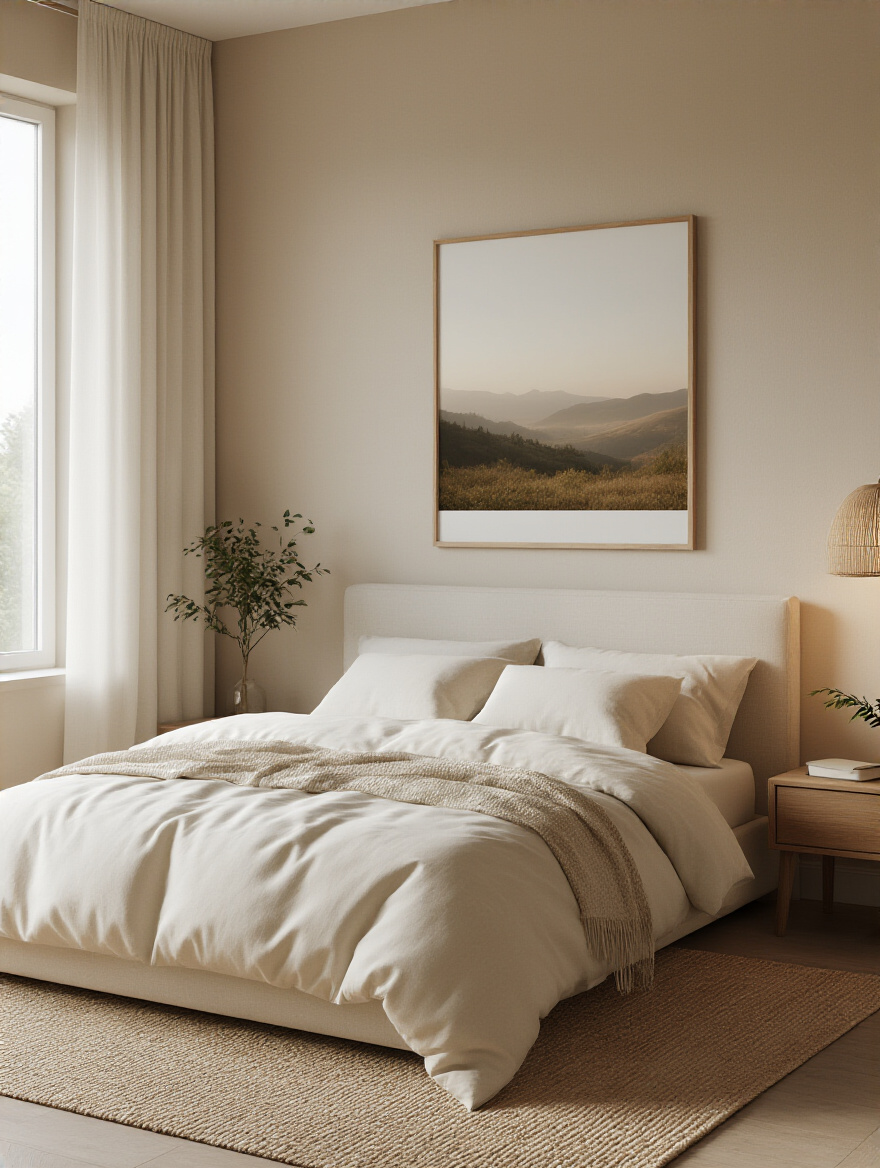
Choose one large, calming piece to hang over the bed or a few similarly-themed pieces on a single wall. Avoid anything that feels jarring, overly bright, or emotionally charged. Personal photos are great, but choose quiet, peaceful moments over dynamic, active shots. The framing should be simple and unobtrusive. The artwork is there to support the serene atmosphere, not to dominate it.
Just like art can nourish the soul, plants can nourish the air.
15. Add Live Plants for Improved Air Quality and Natural Beauty
As someone who works with landscapes, I can tell you that bringing living greenery indoors has a profound psychological effect. Plants connect us to nature, reduce stress, and can even improve air quality. A bedroom is a perfect place for a few carefully chosen plants. They add life, a splash of natural color, and a sense of calm.
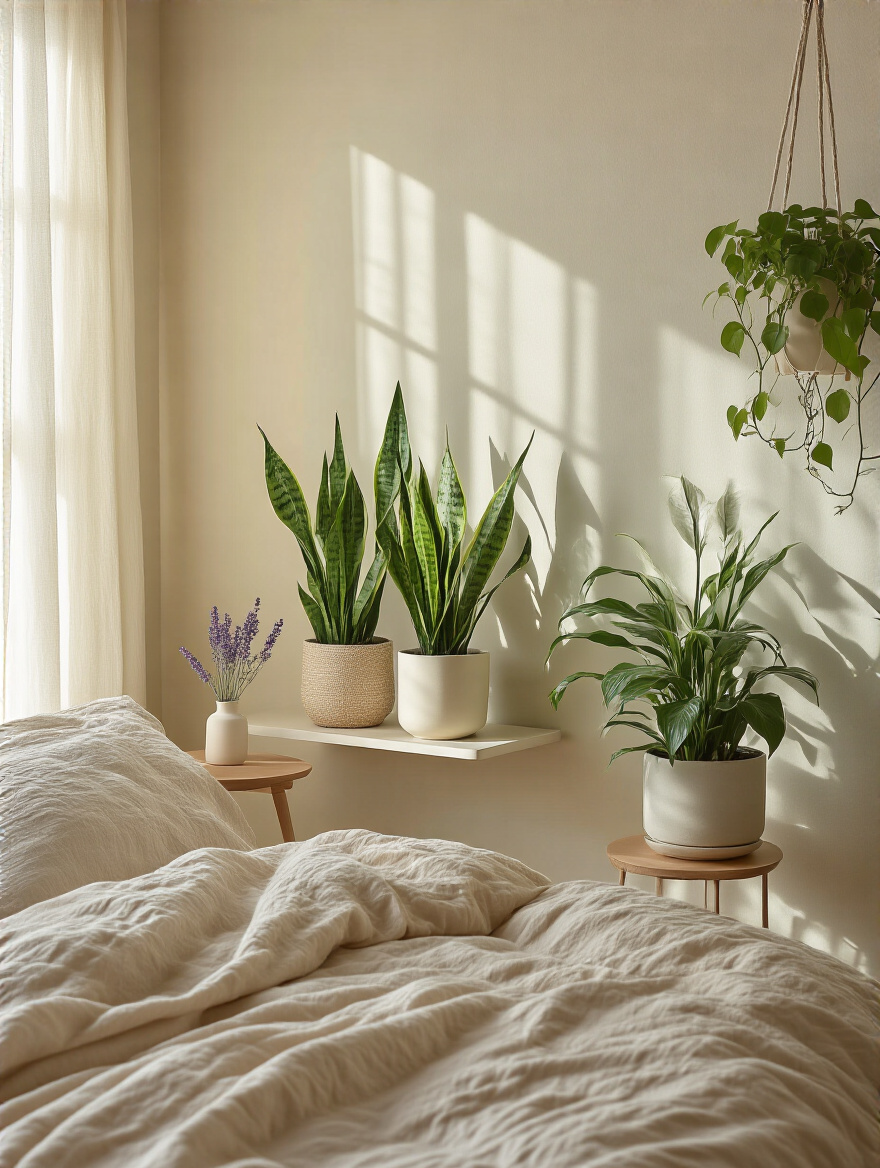
The trick is to choose the right plants. You want low-maintenance varieties that thrive in lower light. Snake plants are fantastic because they actually release oxygen at night. ZZ plants are nearly indestructible, and a trailing pothos adds a beautiful, soft cascade of green. Just a couple of plants in simple, beautiful pots can make a sterile room feel alive and breathing. Just be mindful not to turn it into a jungle; a few well-placed plants are all you need.
Styling and Personal Touches for Tranquility (Part 2)
We’re honing in on the final details that elevate a bedroom from good to great. These touches focus on organization and creating intentional spaces for winding down. It’s about making tranquility easy and accessible, right where you need it most.
16. Organize Your Bedside Table for Easy Access and Minimal Clutter
Your bedside table is the command center for your relaxation. It should be a curated surface holding only the absolute essentials for a peaceful night. A cluttered bedside table is a source of constant low-grade stress. It’s the last thing you see before you close your eyes and the first thing you see when you wake up. Make it a vision of calm.
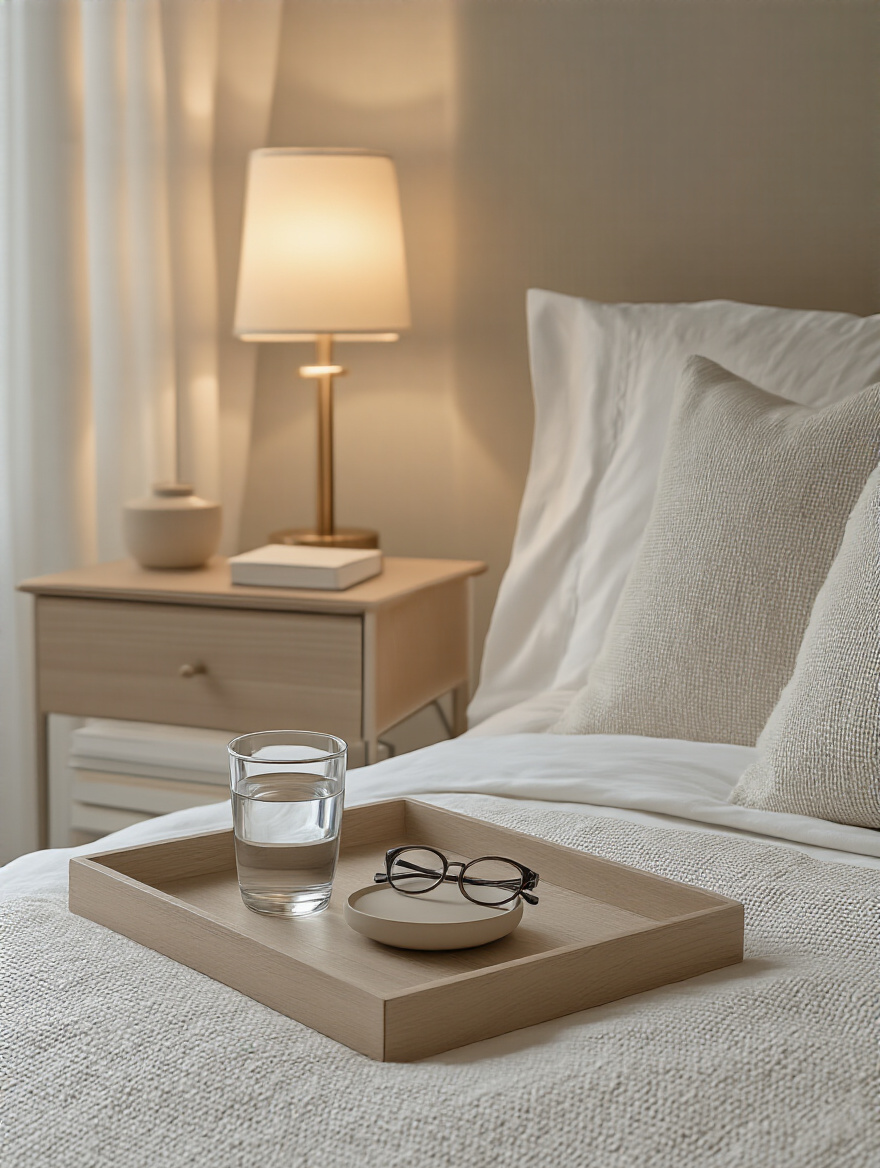
The essentials list is short: a lamp, your current book, a glass of water, and maybe a small tray for your glasses or lip balm. That’s it. Everything else—old magazines, chargers, medication bottles—should be stored away in a drawer. Using a small tray or a beautiful box to contain the little things is a game-changer. It makes everything look intentional and contained, rather than scattered.
Let’s expand that idea of a peaceful zone to a dedicated activity.
17. Create a Dedicated Reading Nook with Proper Task Lighting
We talked about adding an accent chair, but let’s make it official: creating a dedicated reading nook is one of the best things you can do for your sleep health. Reading a physical book under warm, gentle light is an incredible way to signal to your brain that it’s time to disconnect. The key here is the lighting. A good reading light should be directed onto the page without creating glare or lighting up the whole room.
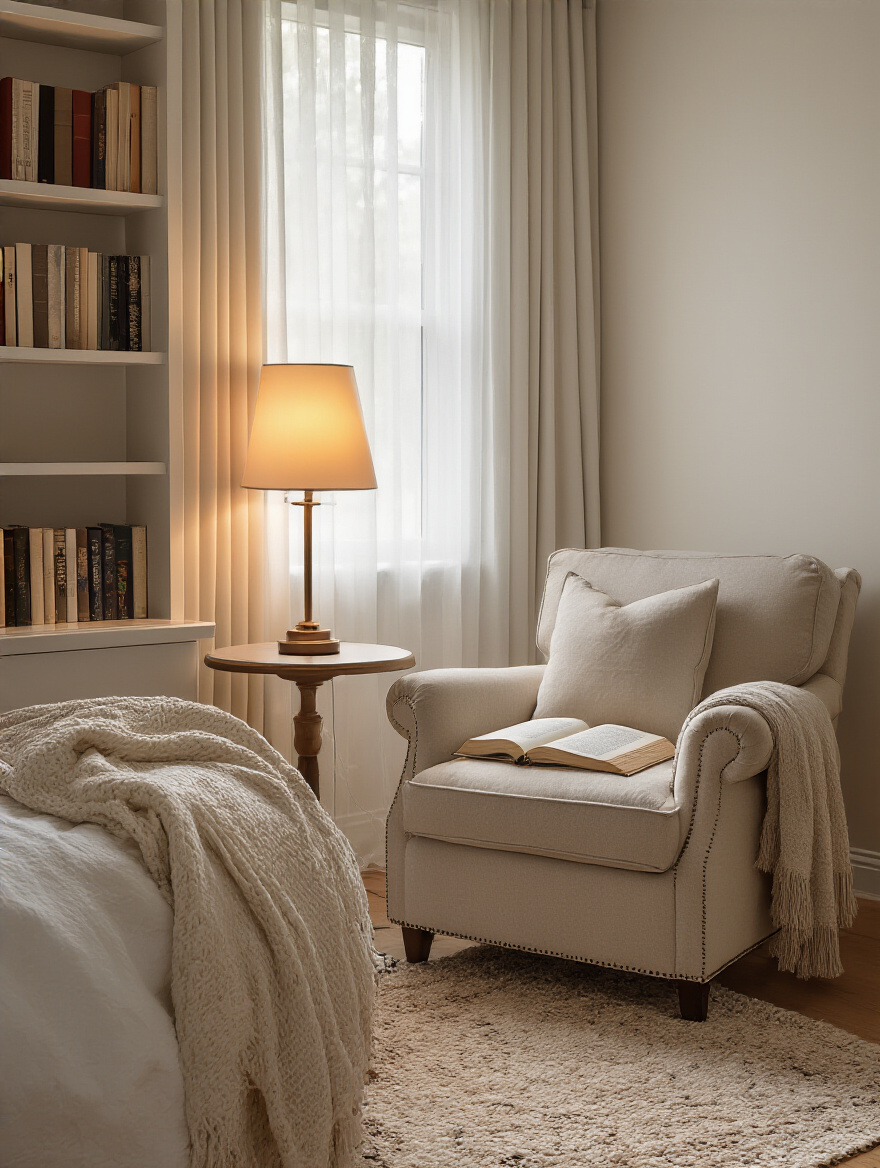
An adjustable floor lamp or a wall-mounted sconce is perfect for this. It keeps the light focused on your book, allowing the rest of the room to stay dim and restful. This little corner becomes a transition zone—a space where you purposefully shift gears from the day’s chaos to the night’s calm. And by keeping this activity out of your bed, you reinforce the message that your bed is purely for sleep.
Advanced Comfort and Daily Rituals
Now we’re moving beyond physical objects into rituals and automations. This is about making comfort effortless and building habits that protect your peace. It’s how you ensure your sanctuary works for you day in and day out, not just when you’ve had time to tidy up.
18. Implement Smart Home Technology for Automated Comfort Control
I was skeptical about smart home tech at first, but for the bedroom, it can be a secret weapon for relaxation. Imagine your lights automatically dimming and shifting to a warm tone an hour before bed. Imagine your thermostat lowering the temperature without you touching it. Imagine a white noise machine starting up on its own. This is about removing the friction from your wind-down routine.
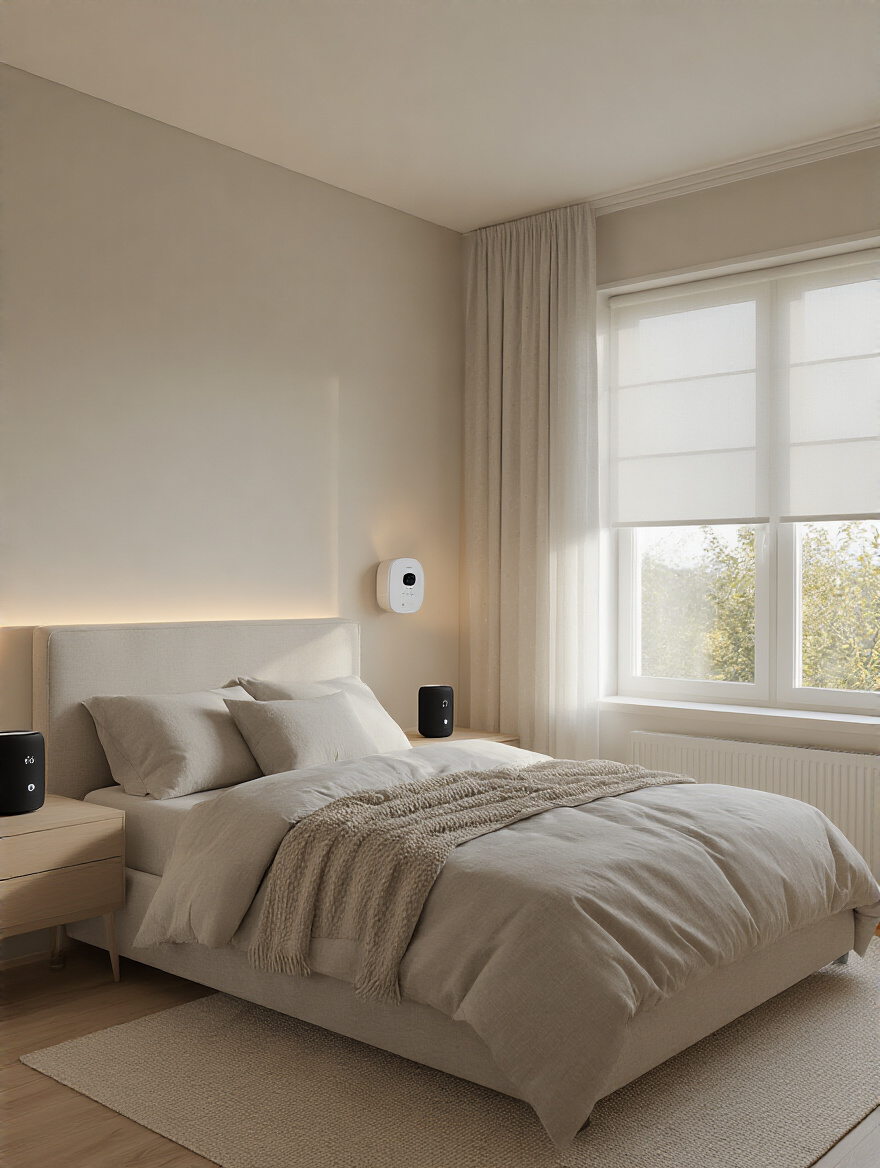
You don’t need to go crazy. Start simple. A few smart bulbs like Philips Hue and a smart thermostat like a Nest or Ecobee can be programmed to create a “Bedtime” scene. With one voice command or a tap on your phone (before your tech curfew, of course), your entire room can shift into a pre-sleep sanctuary. Automation handles the environmental cues so you can focus on simply relaxing.
Speaking of phones, let’s be firm about their place—or lack thereof—in your sanctuary.
19. Designate a Tech-Free Zone to Minimize Digital Distractions
This might be the hardest but most rewarding change you can make. Your bedroom must be a tech-free zone. The blue light from screens wreaks havoc on your melatonin production, and the endless scroll of social media and news keeps your brain in a state of agitated arousal. The temptation to “just check one more thing” is a powerful enemy of sleep.
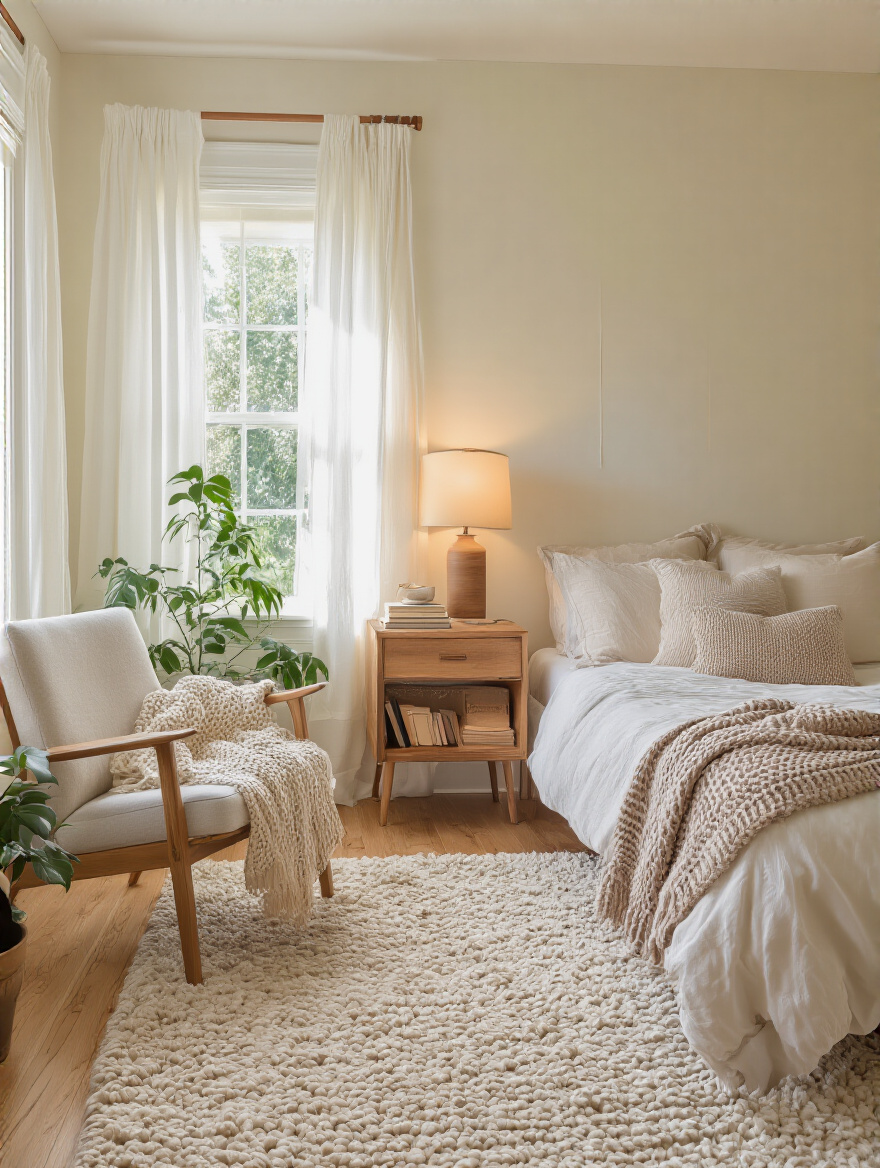
I learned this the hard way when I realized my sleep quality plummeted on nights I worked late on my laptop in bed. The only solution is a hard boundary. Get an old-fashioned alarm clock and charge all your devices—phone, tablet, laptop—in another room overnight. Create a charging station in your kitchen or office. Reclaim your bedroom as a space for analog relaxation. Read a real book. Talk with your partner. Just be still.
Now let’s think about the very air you’re breathing.
20. Maintain Consistent Air Purity with an Air Purifier or Ventilation
We focus so much on what we see and touch, but the quality of the air we breathe all night is huge. Indoor air can be shockingly polluted with dust, pollen, pet dander, and other allergens that can disrupt sleep by causing congestion and irritation. A good HEPA air purifier running quietly in the corner can make a massive difference, especially if you have allergies or live in a city.

Even simpler, get into the habit of ventilating your room. Open a window for 10-15 minutes every morning to flush out stale air and bring in fresh oxygen. A well-ventilated room just feels cleaner and more refreshing, which is exactly the atmosphere you want for a restful night. It’s an invisible layer of comfort that supports your respiratory health while you sleep.
Finally, let’s tie it all together into a powerful daily practice.
21. Establish a Relaxing Pre-Sleep Ritual to Signal Downtime
All these elements—the dim lights, the cool temperature, the calming scent, the tech-free zone—come together to form a pre-sleep ritual. This is the most crucial part. It’s a consistent sequence of events that signals to your entire being that the day is over and it’s time to prepare for rest. It’s not something you do if you have time; it’s a non-negotiable appointment with yourself.
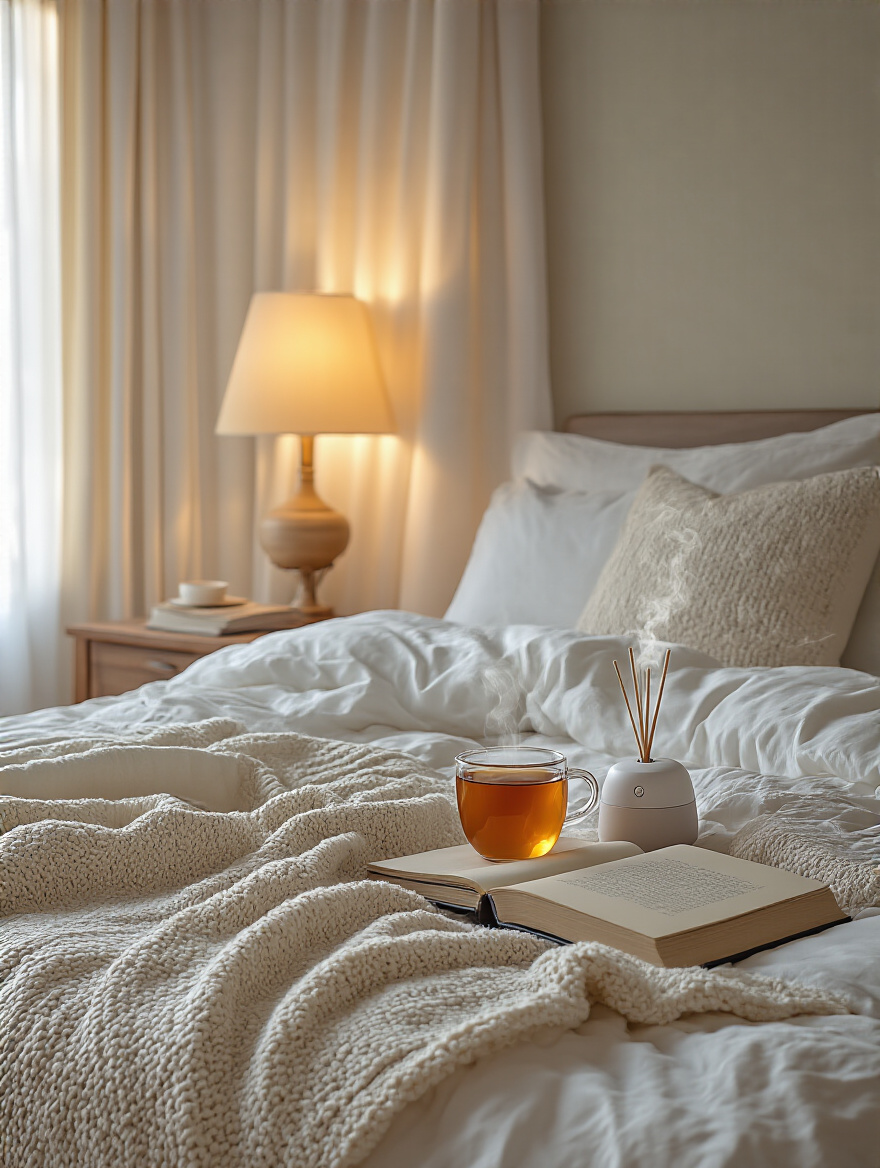
Your ritual can be anything that you find calming. For me, it’s 20 minutes of reading in my armchair, followed by some simple stretches. The key is consistency. When you do the same things in the same order every night, your body learns the cues. The dim lights, the first few pages of a book, the scent of lavender—they become powerful triggers for relaxation. This is how you take control of your sleep and transform your bedroom into a place of profound and predictable rest.
Conclusion
There you have it. Creating a cozy, relaxing bedroom isn’t about buying a bunch of new stuff or following a trend. It’s about being intentional. It’s about building a sanctuary, layer by layer, that supports your well-being. From the foundational layout to the nightly ritual, each step works to create an environment where you can truly let go of the day and sink into deep, restorative sleep.
Don’t feel like you have to do all 21 things at once. Just pick one. Start with decluttering your bedside table this weekend, or order some blackout curtains, or just commit to leaving your phone in the kitchen tonight. Small, consistent changes create the biggest impact over time. Your bedroom should be the most peaceful and personal space in your home. By treating it like the sanctuary it deserves to be, you’re making a powerful investment in your own health and happiness.
